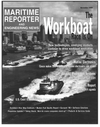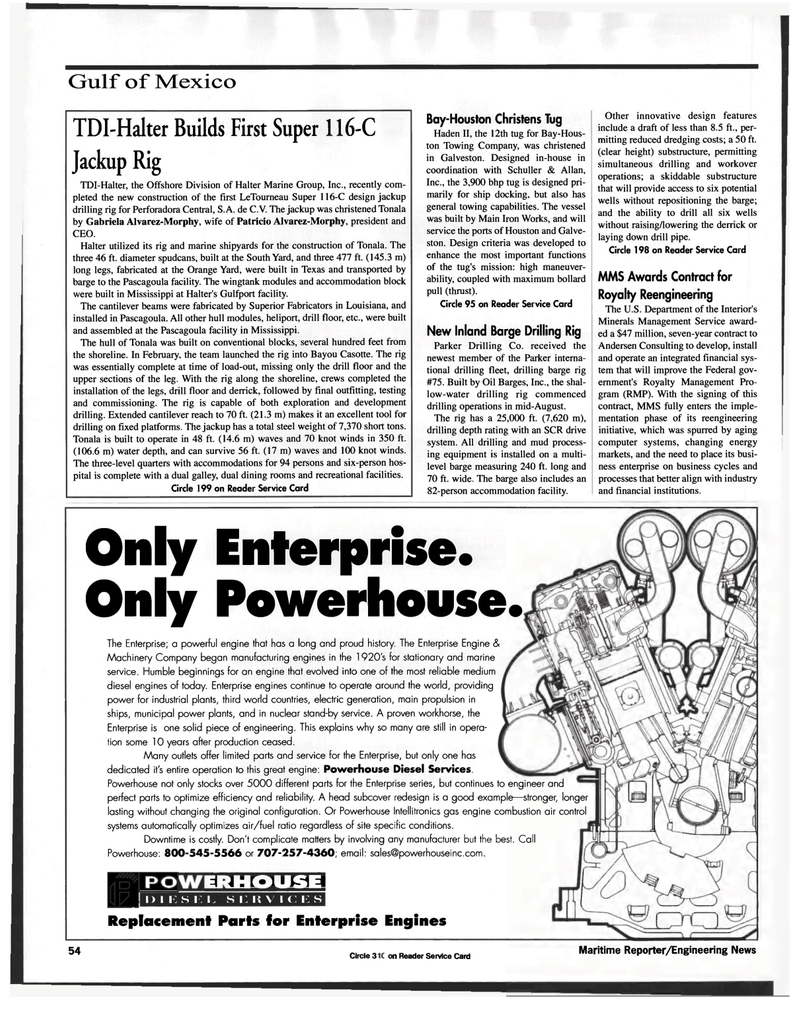
Page 54: of Maritime Reporter Magazine (November 1999)
Read this page in Pdf, Flash or Html5 edition of November 1999 Maritime Reporter Magazine
Gulf of Mexico TDI-Halter Builds First Super 116-C Jackup Rig TDI-Halter, the Offshore Division of Halter Marine Group, Inc., recently com-pleted the new construction of the first LeTourneau Super 116-C design jackup drilling rig for Perforadora Central, S.A. de C.V. The jackup was christened Tonala by Gabriela Alvarez-Morphy, wife of Patricio Alvarez-Morphy, president and CEO. Halter utilized its rig and marine shipyards for the construction of Tonala. The three 46 ft. diameter spudcans, built at the South Yard, and three 477 ft. (145.3 m) long legs, fabricated at the Orange Yard, were built in Texas and transported by barge to the Pascagoula facility. The wingtank modules and accommodation block were built in Mississippi at Halter's Gulfport facility. The cantilever beams were fabricated by Superior Fabricators in Louisiana, and installed in Pascagoula. All other hull modules, heliport, drill floor, etc., were built and assembled at the Pascagoula facility in Mississippi. The hull of Tonala was built on conventional blocks, several hundred feet from the shoreline. In February, the team launched the rig into Bayou Casotte. The rig was essentially complete at time of load-out, missing only the drill floor and the upper sections of the leg. With the rig along the shoreline, crews completed the installation of the legs, drill floor and derrick, followed by final outfitting, testing and commissioning. The rig is capable of both exploration and development drilling. Extended cantilever reach to 70 ft. (21.3 m) makes it an excellent tool for drilling on fixed platforms. The jackup has a total steel weight of 7,370 short tons. Tonala is built to operate in 48 ft. (14.6 m) waves and 70 knot winds in 350 ft. (106.6 m) water depth, and can survive 56 ft. (17 m) waves and 100 knot winds. The three-level quarters with accommodations for 94 persons and six-person hos-pital is complete with a dual galley, dual dining rooms and recreational facilities. Circle 199 on Reader Service Card Bay-Houston Christens Tug Haden II, the 12th tug for Bay-Hous-ton Towing Company, was christened in Galveston. Designed in-house in coordination with Schuller & Allan, Inc., the 3,900 bhp tug is designed pri-marily for ship docking, but also has general towing capabilities. The vessel was built by Main Iron Works, and will service the ports of Houston and Galve-ston. Design criteria was developed to enhance the most important functions of the tug's mission: high maneuver-ability, coupled with maximum bollard pull (thrust). Circle 95 on Reader Service Card New Inland Barge Drilling Rig Parker Drilling Co. received the newest member of the Parker interna-tional drilling fleet, drilling barge rig #75. Built by Oil Barges, Inc., the shal-low-water drilling rig commenced drilling operations in mid-August. The rig has a 25,000 ft. (7,620 m), drilling depth rating with an SCR drive system. All drilling and mud process-ing equipment is installed on a multi-level barge measuring 240 ft. long and 70 ft. wide. The barge also includes an 82-person accommodation facility. Other innovative design features include a draft of less than 8.5 ft., per-mitting reduced dredging costs; a 50 ft. (clear height) substructure, permitting simultaneous drilling and workover operations; a skiddable substructure that will provide access to six potential wells without repositioning the barge; and the ability to drill all six wells without raising/lowering the derrick or laying down drill pipe. Circle 198 on Reader Service Card MMS Awards Contract for Royalty Reengineering The U.S. Department of the Interior's Minerals Management Service award-ed a $47 million, seven-year contract to Andersen Consulting to develop, install and operate an integrated financial sys-tem that will improve the Federal gov-ernment's Royalty Management Pro-gram (RMP). With the signing of this contract, MMS fully enters the imple-mentation phase of its reengineering initiative, which was spurred by aging computer systems, changing energy markets, and the need to place its busi-ness enterprise on business cycles and processes that better align with industry and financial institutions. Only Enterprise. Only Powerhouse. The Enterprise; a powerful engine that has a long and proud history. The Enterprise Engine & Machinery Company began manufacturing engines in the 1920's for stationary and marine service. Humble beginnings for an engine that evolved into one of the most reliable medium diesel engines of today. Enterprise engines continue to operate around the world, providing power for industrial plants, third world countries, electric generation, main propulsion in ships, municipal power plants, and in nuclear stand-by service. A proven workhorse, the Enterprise is one solid piece of engineering. This explains why so many are still in opera-tion some 10 years after production ceased. Many outlets offer limited parts and service for the Enterprise, but only one has dedicated it's entire operation to this great engine: Powerhouse Diesel Services. Powerhouse not only stocks over 5000 different parts for the Enterprise series, but continues to engineer and perfect parts to optimize efficiency and reliability. A head subcover redesign is a good example?stronger, longer lasting without changing the original configuration. Or Powerhouse Intellitronics gas engine combustion air control systems automatically optimizes air/fuel ratio regardless of site specific conditions. Downtime is costly. Don't complicate matters by involving any manufacturer but the best. Call Powerhouse: 800-545-5566 or 707-257-4360; email: [email protected]. n CE =11! Ml W J n 1) 1 E s i: 1. S i: KV1CES Replacement Parts for Enterprise Engines 54 Circle 337 on Reader Service Card Maritime Reporter/Engineering News

 53
53

 55
55
